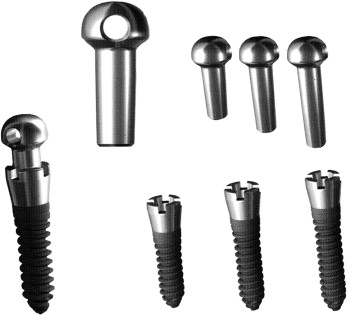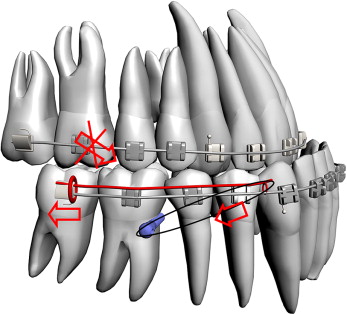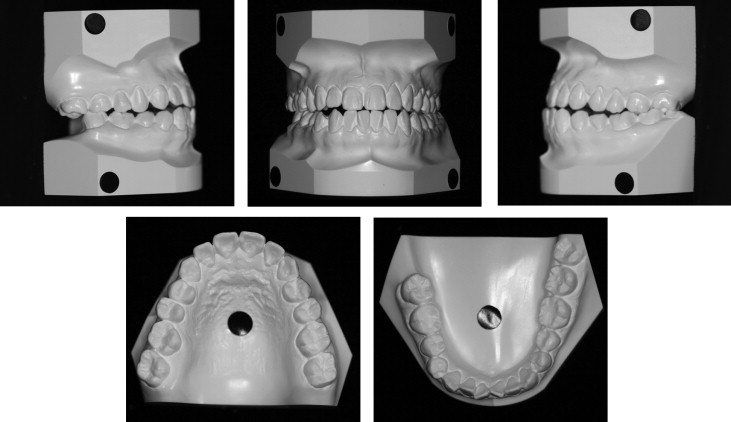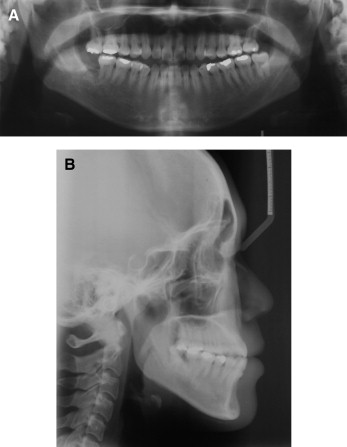This article describes the orthodontic treatment for a young woman, aged 23 years 5 months, with a Class III malocclusion and a deviated midline. Two orthodontic mini-implants (C-implants, CIMPLANT Company, Seoul, Korea) were placed in the interdental spaces between the mandibular second premolars and first molars. The treatment plan consisted of distalizing the mandibular dentition asymmetrically and creating space for en-masse retraction of the mandibular anterior teeth. C-implants were placed to provide anchorage for Class I intra-arch elastics. The head design of the C-implant minimizes gingival irritation during orthodontic treatment. Sliding jigs were applied buccally for distalization of the mandibular posterior teeth. The active treatment period was 18 months. Normal overbite and overjet were obtained, and facial balance was improved.
Every orthodontic tooth movement is accompanied by a reaction. This can make it difficult to correct a malocclusion by using intraoral appliances alone, especially when complete distal movement of the mandibular dentition is planned in nonsurgical Class III malocclusion treatment. Traditionally, fixed appliances and intermaxillary elastics have been used to move mandibular molars distally, often resulting in undesirable proclination of the maxillary incisors and extrusion of the maxillary molars as reciprocal side effects. This can cause an esthetic problem and instability, especially in long-faced adults. Also, because intermaxillary elastic wear requires patient compliance, it is difficult to predict the final result in uncooperative patients. Therefore, several authors have attempted to treat this type of malocclusion by distal tooth movement alone. For example, animal studies and clinical investigations have used conventional implants as absolute anchorage and miniplates for intrusion or distalization of the mandibular posterior teeth. Because all portions of the anchor plates and screws were placed outside the dentition in these studies, it was possible to move the mandibular molars without disturbing tooth movement.
Recently, the mechanics of group distal movement of teeth with microscrew implant anchorage was introduced. A distalizing force is applied to the canines through a nickel-titanium (NiTi) coil spring connecting the miniscrew to hooks on the archwire. The primary treatment effect in the mandible is distal tipping movement of the posterior teeth concurrent with uprighting and distal movement of the anterior teeth. Because there is no force to move the maxillary anterior teeth forward (via Class III elastics), there are no side effects on the maxillary anterior teeth in microscrew implant-aided mechanics. Therefore, distal movement assisted by a rigid orthodontic implant can be a good alternative for treatment when intermaxillary elastics are not indicated or the patient is uncooperative.
The stability of temporary skeletal anchorage devices is achieved from primary mechanical retention between the implant surface and the cortical bone, and secondary stability is provided by the healing process of the surrounding tissue. Primary stability is important to minimize the potential for failure from micromotion. Secondary stability is related to the microstructure of the implant surface. In conventional dental prosthetic implants, implants with a rough surface showed better stability and tissue reactions than did those with a smooth surface. In orthodontic implants, porous-surfaced implants show higher marginal bone levels and less relative implant displacement than threaded implants.
The C-implant (CIMPLANT Company, Seoul, Korea) was developed to use osseointegration as the main stabilizing mechanism. This mini-implant has an upper abutment head component and a lower threaded body or screw-type component ( Fig 1 ). The unique head design makes it possible to apply multiple elastics while simultaneously preventing the elastics from slipping off. The body or retentive component of the C-implant is better able to resist the rotational tendency of heavy dynamic loads and control 3-dimensional tooth movement as a result of its higher osseointegration potential.

When distalizing the mandibular dentition with a mandibular C-implant, the most important consideration is its position. The placement site should be as close as possible to the mesial surface of the mandibular first molar because this will help achieve optimal distalization of the mandibular dentition. The initial tooth movement in distalization is posterior movement of the second molar by using a sliding jig that is connected to the main archwire, followed by moving the other teeth posteriorly ( Fig 2 ). While the second molar is distalizing, the first molar also moves distally as a result of drifting. When molar distalization is complete, the premolars will also begin to move with the sliding jig. While the premolars are distalizing, spaces might develop between the anterior teeth. To retract the anterior teeth with en-masse retraction, closing loops are placed between the lateral incisors and canines, and connected to the C-implants by elastics. Because intermaxillary elastics are not applied to the maxillary dentition, mesial movement of the maxillary arch and extrusion of the maxillary molars are avoided, and the incisors are not flared. This case report describes the distalization of the mandibular dentition to treat a dental Class III malocclusion with a deviated midline by using C-implants.

Diagnosis
The patient was a woman, aged 23 years 5 months, whose chief concern was protruding mandibular teeth. Her medical history was noncontributory, and occasional clicking of her temporomandibular joints (TMJ) was noted in her dental history.
The pretreatment facial photographs ( Fig 3 ) show an acceptable facial profile, despite mild midface deficiency and slight mandibular prognathism. No facial asymmetry was noticeable in the frontal view. The clinical examination ( Figs 3 and 4 ) showed a Class III molar and canine relationship that was more significant on the right side. Other findings included an anterior edge-to-edge relationship, a midline discrepancy, mild mandibular anterior crowding, and mesial angulation of the mandibular posterior teeth. The lower midline was not coincident with the facial midline and was shifted to the left by 2.5 mm. The maxillary third molars and the mandibular right third molar were missing ( Fig 5 A ). There was only slight contact between the maxillary right second molar and the opposing tooth because of the Class III molar relationship.



The cephalometric analysis ( Fig 5 B ; Table ) showed a skeletal Class III relationship with a high mandibular plane angle and a slightly retrognathic maxilla. The anterior facial height was slightly long relative to the posterior facial height. The incisor position and interincisal relationship were within normal limits except for the retroclined maxillary incisor. The patient was diagnosed with a skeletal Class I malocclusion with mild maxillary deficiency and a dental Class III relationship.
| Measurement | Average (women) ∗ | Pretreatment | Posttreatment |
|---|---|---|---|
| SNA (°) | 81.6 | 77 | 76.5 |
| SNB (°) | 79.2 | 76.5 | 76 |
| ANB difference (°) | 2.4 | 0.5 | 0.5 |
| PFH/AFH (%) | 85.1/127.4 (66.8) | 88.5/137 (64.6) | 91/140.5 (64.8) |
| SN-OP (°) | 17.9 | 20.6 | 18 |
| FH-U1 (°) | 116.0 | 109.5 | 110 |
| FMA (°) | 24.3 | 33 | 33.5 |
| IMPA (°) | 95.9 | 91 | 80 |
| FMIA (°) | 59.8 | 56 | 66.5 |
| UL-E plane (mm) | −0.9 | −1.5 | −1 |
| LL-E plane (mm) | 0.6 | 1 | 0.5 |
| Interincisal angle | 123.8 | 127.5 | 136.5 |
| Mx 1-NA (mm) | 7.3 | 7 | 7.5 |
| Mx 1-NA (°) | 25.3 | 24 | 26 |
| Mn 1-NB (mm) | 7.9 | 8 | 4.5 |
| Mn 1-NB (°) | 28.4 | 27.3 | 17 |
| SN-PP (°) | 10.2 | 9.5 | 9.5 |
∗ For Korean women, data from, Korean Association of Orthodontists.
Treatment objectives
A mandibular premolar extraction plan would be a relatively simple and stable way to resolve the anterior crossbite. Complex treatment mechanics and many tooth movements would not be needed. However, the patient did not want extractions (except for the third molars) or changes to her facial appearance; she wanted only to correct the incisor relationship. Although the maxillary incisors were slightly upright, the patient requested that they not be allowed to move forward. Therefore, we rejected the premolar-extraction treatment option.
Based on the initial records and the patient’s desires, the treatment objectives were to distalize all mandibular teeth, improve the interincisal relationship to have normal overjet and overbite, shift the mandibular midline to coincide with the facial and maxillary midlines, and achieve Class I canine and molar intercuspal relationships. A conventional fixed appliance was prescribed.
Treatment objectives
A mandibular premolar extraction plan would be a relatively simple and stable way to resolve the anterior crossbite. Complex treatment mechanics and many tooth movements would not be needed. However, the patient did not want extractions (except for the third molars) or changes to her facial appearance; she wanted only to correct the incisor relationship. Although the maxillary incisors were slightly upright, the patient requested that they not be allowed to move forward. Therefore, we rejected the premolar-extraction treatment option.
Based on the initial records and the patient’s desires, the treatment objectives were to distalize all mandibular teeth, improve the interincisal relationship to have normal overjet and overbite, shift the mandibular midline to coincide with the facial and maxillary midlines, and achieve Class I canine and molar intercuspal relationships. A conventional fixed appliance was prescribed.
Stay updated, free dental videos. Join our Telegram channel

VIDEdental - Online dental courses


